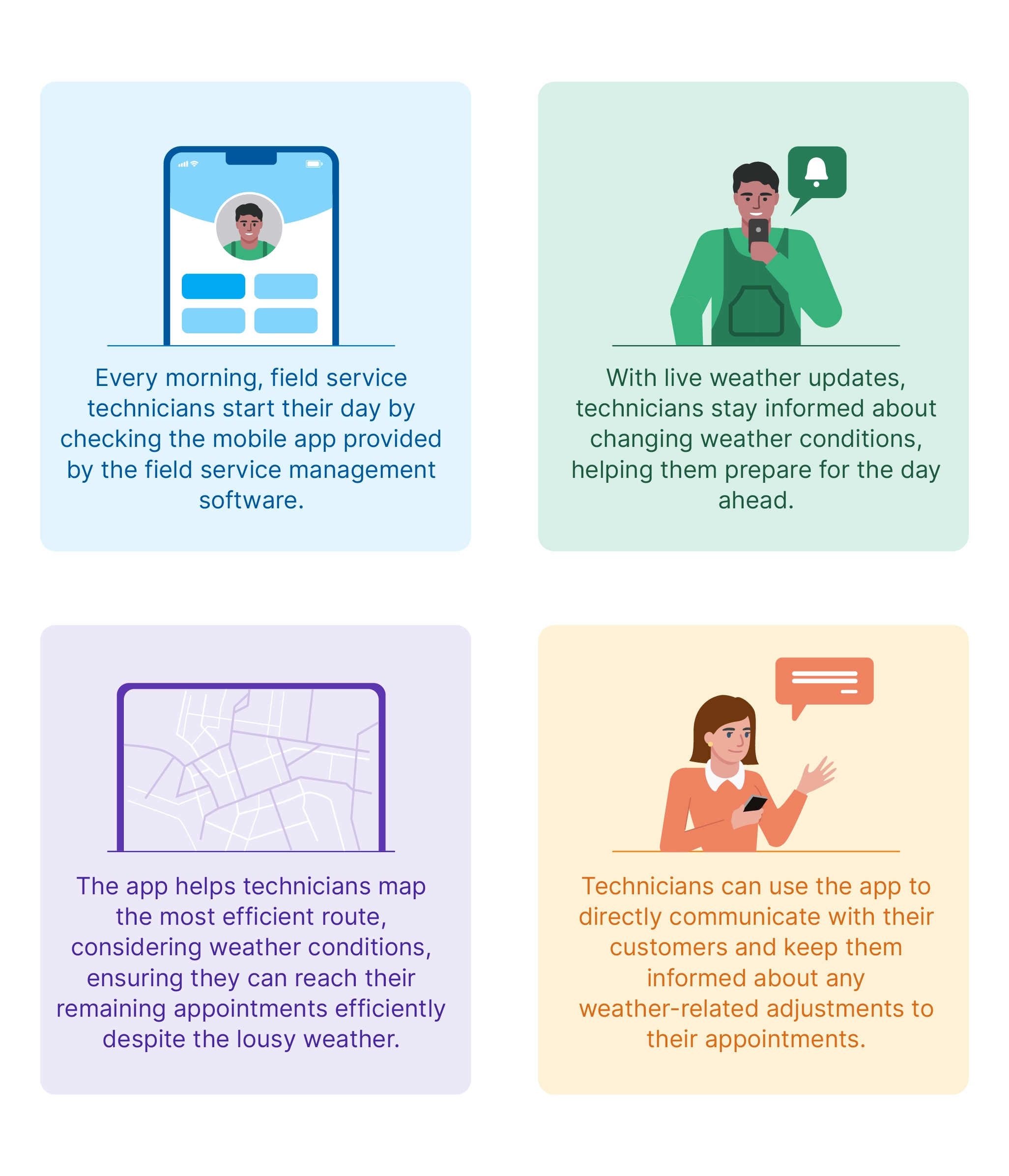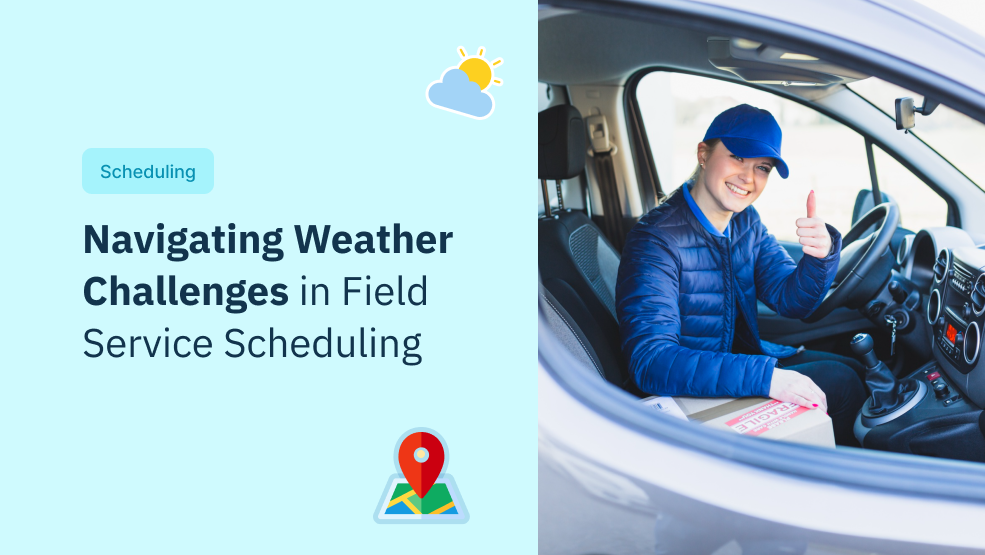The fast-paced world of field service thrives on efficiency and precision. According to a 2019 study by Eskom, a South African utility giant, two-thirds of field service managers must rely on weather data for daily operations. This statistic underscores the significant impact weather can have on field service success.
Field service businesses like yours can orchestrate a logistical ballet to meet customer needs, from juggling appointments to navigating complex routes. However, amidst these intricacies lies an often-underestimated challenge—the weather. This article explores the multifaceted influence of weather on field service operations, highlighting the importance of effective scheduling as a risk mitigation strategy and a cornerstone of technician safety.
The impact of weather on field service operations
When it comes to field service operations, sunshine and clear skies aren’t the only things technicians see. Weather can be a significant disruptor in all its unpredictable forms. It can disturb even the most meticulously planned schedules. Picture this. A heavy downpour transforms a routine 30-minute drive into a two-hour odyssey. Pre-planned schedules go awry. Customers may get frustrated waiting for technicians who are battling the elements. These are just several examples of how weather can lead to delays and disrupt the smooth functioning of a field service business.
But delays are just the tip of the iceberg. Slippery roads due to rain, snow, or ice create hazardous working conditions, increasing technicians’ risk of slips, falls, and injuries. Strong winds can pose a significant danger when working at heights or on ladders. Not to mention, certain weather conditions can also limit a technician’s ability to perform tasks effectively. Heavy rain might make diagnosing electrical problems outdoors nearly impossible, while high winds could make satellite dish installation a precarious undertaking.
Beyond the safety of technicians and the efficiency of their work, extreme weather can also pose a threat to equipment. Delicate parts and equipment can be susceptible to damage from rain, causing malfunctions. Extreme heat or cold can shorten battery life or lead to overheating sensitive devices.
The impact doesn’t stop there. Customer satisfaction can take a hit when inclement weather disrupts schedules. Delayed appointments, missed service windows, and technicians rushing to complete tasks due to time constraints can all lead to a negative customer experience. Understanding these diverse ways weather can disrupt your operations is the first step towards developing effective mitigation strategies.
The importance of mitigating risks in field service scheduling
So, why do you need to adapt proactive scheduling to mitigate weather risks? Here are the essential reasons that effective field service scheduling will benefit you in various aspects.
Enhanced customer satisfaction
If a customer waits hours for a technician because their appointment coincided with a sudden downpour. It may disrupt the customer’s day and leave a negative impression of your service. When you incorporate weather forecasts into field service scheduling, you can proactively anticipate potential delays and communicate adjustments to customers. Such practices of transparency build trust and foster a more positive customer experience.
Reduced operational costs
Weather-related delays can have a ripple effect on your bottom line. Technicians stuck in traffic due to bad weather are not generating revenue. Missed appointments or rescheduled work can lead to inefficiencies and wasted resources. Proactive scheduling that considers weather forecasts allows you to optimize routes, minimize delays, and ensure technicians are utilized effectively.
Improved technician safety
Certain weather conditions create hazardous work environments for technicians. For example, icy roads pose a significant risk of accidents, while strong winds can be dangerous for technicians working at heights. When you factor weather forecasts into your scheduling system, you can avoid assigning high-risk tasks during adverse weather conditions. And so you can prioritize the safety and well-being of your technicians.
A study by the American Society of Safety Engineers (ASSE) found that weather-related incidents are a leading cause of workplace injuries. Start incorporating weather risk mitigation into scheduling, and you can significantly reduce the likelihood of such incidents.
Incorporating weather data into scheduling can also provide valuable insights for long-term planning. For instance, analyzing historical weather patterns can help identify seasons or times of day that are more susceptible to disruptions. This information can be used to adjust staffing levels or prioritize specific tasks during those periods.
Utilizing real-time weather updates for efficient scheduling
The good news for field service businesses is that the fight against unpredictable weather isn’t one-sided. Today’s digital age offers a powerful weapon in the form of real-time weather updates. These updates, constantly streamed from weather monitoring stations and satellites, provide a dynamic picture of current and upcoming weather conditions. Integrating these updates into your scheduling modules can transform your decision-making process from reactive to proactive.
Picture this. A technician is scheduled for an appointment in an area forecast for clear skies. Suddenly, real-time weather updates show a fast-moving storm head brewing near that location. With this advanced warning, you can take immediate action. Rescheduling the appointment or reassigning the technician to a different area allows them to avoid the storm and complete their tasks safely and efficiently.
The benefits of utilizing real-time weather updates extend beyond immediate response
Dynamic route optimization
Traffic congestion caused by sudden downpours or snowstorms can significantly disrupt schedules. When you factor real-time weather data into route planning, you can identify potential trouble spots and dynamically adjust routes to minimize delays. Adopting route planning software that implements real-time weather updates ensures that technicians will be able to complete more jobs and spend less time fighting the elements.
Enhanced customer communication
Real-time weather updates empower you to keep your customers informed. Appointments that need to be rescheduled because of weather can be. Proactively communicating with your customer that a change has occurred and why will help foster trust. Transparency regarding what is going on and why rescheduling is necessary—and offering alternative timeslots that will work for your customer—will lead to stronger customer relationships in the long run.
According to a study by Salesforce, 73% of customers expect companies to use their data to provide them with personalized experiences. Leveraging real-time weather data to manage appointments proactively demonstrates a commitment to customer satisfaction and building strong relationships.
Real-time weather updates are a game-changer for field service businesses. Integrating them into your scheduling systems gives you a powerful tool to navigate the ever-changing weather landscape. What’s more, you can ensure technician safety and deliver exceptional customer service.
Regularly inspecting for high winds
High winds deserve special attention in field service operations and the various weather hazards. Strong winds can transform a routine task into a dangerous situation for technicians working at heights, on ladders, or with equipment susceptible to gusts. Here’s why incorporating regular inspections for high wind conditions into your safety protocols is paramount.
Proactive risk awareness
Regularly checking wind forecasts and establishing clear thresholds for unsafe working conditions empower your technicians with crucial information. So they can be proactive in identifying potential hazards and adjust their approach accordingly. For instance, a technician scheduled to work on a rooftop might reschedule the task, implement additional safety measures like sturdier anchors, or double-check their harness securement if high winds are predicted.
Reduced risk of accidents
Wind gusts can significantly impact balance and stability, especially when working at elevations. When technicians are aware of wind forecasts and take appropriate precautions, they can significantly reduce the risk of slips, falls, and other wind-related accidents. This protects their physical well-being and minimizes potential downtime and costs associated with workplace injuries.
Improved decision-making
Regular wind inspections provide technicians with the information they need to make informed decisions on the job. If a technician arrives at a worksite and encounters unexpectedly strong winds. Having access to recent wind data allows them to assess the situation and make a quick yet informed decision on whether to proceed, reschedule, or implement additional safety measures.
The Occupational Safety and Health Administration (OSHA) recommends employers develop and implement a comprehensive fall protection plan. Regular wind inspections can be a valuable component of such a plan, ensuring technicians working at heights are aware of potential wind hazards and take appropriate precautions to mitigate risks. Prioritize regular wind inspections so you can demonstrate a commitment to the safety of their technicians.
Leveraging technology for enhanced safety and boosted efficiency
In the battle against unpredictable weather, field service businesses don’t have to fight alone. Technology offers a powerful arsenal of tools that can significantly enhance safety, optimize scheduling, and ensure efficient operations even when faced with adverse weather conditions.
Intelligent scheduling with field service management software
Field service management (FSM) software is more than just a scheduling tool—it’s a strategic weapon. Integrate weather data into FSM software so field service businesses like you can create dynamic schedules that are responsive to real-time weather updates.
Proactive rescheduling
Imagine a snowstorm suddenly blankets a specific region. FSM software with weather integration can automatically identify appointments in that area and flag them for potential disruption. This empowers dispatchers to proactively reschedule appointments or reassign technicians to avoid delays and ensure their safety.
Optimized route planning
Traffic congestion caused by bad weather can throw even the most meticulously planned schedules into disarray. FSM software can leverage real-time weather data to adjust routes dynamically, identify alternative pathways around trouble spots, and ensure technicians spend less time stuck in traffic and more time completing jobs efficiently.
Mobile apps to empower technicians with real-time weather updates
The power of technology extends beyond the back office. Mobile apps equipped with real-time weather updates can become vital safety companions for technicians in the field when technicians are on their way to a customer location. A sudden downpour shows up on their mobile app. Armed with this knowledge, they can adjust their driving speed, plan for potential delays, or even reach out to the customer to discuss rescheduling options.
Mobile apps can also serve as safety communication hubs. They can be used to:
Disseminate safety alerts
During severe weather events, dispatchers can send real-time safety alerts to technicians in the field. These mobile app alerts can warn them of potential hazards, advise them to seek shelter or remind them of necessary safety protocols to follow in specific weather conditions.
Incident reporting
Mobile apps can streamline the process of reporting weather-related incidents. Technicians can quickly document any issues encountered due to bad weather, such as slippery work sites or damaged equipment. This real-time data allows businesses to identify trends, adjust protocols, and continuously improve safety measures.
Field service businesses can leverage technology to create a dynamic and responsive safety net by embracing FSM software and equipping technicians with mobile apps. This protects technicians from weather-related hazards and optimizes scheduling and resource allocation, ultimately leading to a more efficient and successful operation.

How do Grime Fighters use FSM software to conquer weather challenges?
Grime Fighters, a renowned building maintenance and cleaning service provider in the Lower Mainland Region of British Columbia (BC), Canada, faces unique challenges from October to March during the intense winter season. Offering a comprehensive winter solution, including salting and snow removal, Grime Fighters ensures accessibility and reduces the liability associated with slips and falls for their diverse customers, ranging from commercial to public buildings. However, managing over 30 routes with 70+ staff across 160 locations during unpredictable snow days presents significant hurdles. Grime Fighters must swiftly adapt to changing weather conditions while maintaining service excellence. Also, they identified the need to streamline communication and coordination between field and office staff, aiming to enhance job tracking and documentation to meet SLA requirements.
Grime Fighters turned to the Zuper field service management app to address these challenges, integrating seamlessly with their existing Salesforce CRM. This integration revolutionized their operations, bringing increased efficiency, accuracy, and collaboration between office and field workers. With automated scheduling and dispatching features, Grime Fighters optimized routes, reduced fuel costs, and improved customer service by ensuring prompt response times.
Zuper facilitated better field operations management through automated scheduling, real-time tracking, and comprehensive data collection. This enabled Grime Fighters to make informed decisions regarding staffing, routes, and job priorities. Also, the app empowered them to provide accurate reporting tracking salts used in field operations to enhance job efficiencies and customer satisfaction. Grime Fighters’ successful integration of Zuper exemplifies how innovative field service management solutions can help companies navigate weather challenges, ensuring technician safety and customer satisfaction while optimizing operations and reducing costs.
Final thoughts
Weather-proofing your field service business is a vital aspect of ensuring the safety of your technicians and optimizing your operations. By understanding the impact of weather on field service operations, implementing efficient scheduling techniques, prioritizing safety protocols, and complying with OSHA guidelines, you can mitigate risks and protect your technicians from potential harm. Remember, investing in the well-being of your technicians ultimately leads to improved customer satisfaction and the long-term success of your business.
Get a personalized demo today if you’d like to see how Zuper can help you navigate weather challenges in your service scheduling and run your business smoothly. And see how field service management software can change how you do business.







